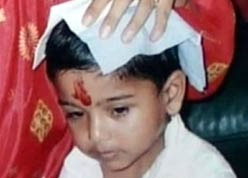Dec 28, 2025
Dec 28, 2025
Two children in India were freed on Friday from two different states of bondage. One, the much hyped case of Anant, 3 year old son of Senior Vice President of Adobe Naresh Gupta who rejoined his parents in their plush residence in Sector 15 A of the National Capital Region’s, NOIDA District after released by his kidnappers. The cherubic child was fortunately unharmed both physically as well as mentally and seemed to be in good cheer, quite unaware of the threat of death posed by his kidnappers and the Rs 50 Lakh ransom reportedly paid by his father. Anant resumed his pranks with his sister and friends and will surely grow up to memories of friendly “uncles” who fed him chocolates and toys, while in captivity.
 Anant also became an instant television celebrity and appeared quite comfortable with the attention of the flash bulbs and television mikes pushed into his arms by enthusiastic journalists happy to be part of the melodrama. The mystery of his return home will remain as the police claimed that they had caught one of the culprits and also retrieved the ransom money.
Anant also became an instant television celebrity and appeared quite comfortable with the attention of the flash bulbs and television mikes pushed into his arms by enthusiastic journalists happy to be part of the melodrama. The mystery of his return home will remain as the police claimed that they had caught one of the culprits and also retrieved the ransom money.
The recovery of the child was indeed fortunate for the badlands of Western Uttar Pradesh in India are known as India’s Wild West, dominated by gun culture. Kidnapping, extortion and ransom is considered a macho activity in tune the martial traditions of the ravines and rugged terrain across the expanse of the districts of Fatehgarh, Meerut, Shahjahanpur, Badaun, Mainpuri and Etah, some home to many of the states ministers and renowned political class. The gun is the most prized possession in this area and the ability to obtain an arms license for supporters determines the popularity of a leader, many times, the sole election winning factor. The victims as little Anant are targeted based on the parents ability to pay and the ease with which the operation can be carried out. The support network of the child is effectively penetrated and the kidnapping conducted at the most opportune time. This operation too went off well except for the fact that Naresh Gupta was a well known personality, heading a multi national in India and the authorities feared that any untoward incident would affect the prospects of growth of IT industry in NOIDA. It was thus natural that the police quickly swung into action with even the Chief Minister of the State, chipping in.
The second child to be released from captivity of another kind was Ritesh, a 13 year old who was rescued from a zari factory again in Delhi, the national capital. The boy is one amongst three children of an unemployed woman who was struggling to eke out a living after the death of her husband. The Labor Department of the State promised to rehabilitate, the child a singular boon to the mother who is finding it difficult to make both ends meet.
Ritesh’s story did not lead to any head lines or attention grabbing in the media, except for the Indian Express, the only national daily which covered it after changing the name of the boy for understandable reasons. Yet it demonstrated the other side of bondage of children in India, of impoverishment, forced labor and abuse. The exploiters of such children as Ritesh are no less despicable as the kidnappers of Anant, probably more so. They neither provided their victims chocolates nor proper compensation, but only frequent thrashings as seen from the scars on the hands of the child indicated in the Express report.
Surely Anant will recover from the trauma of his kidnapping. He has an excellent support system at school and home, of wealth, affluence, loving parents, relatives and friends. The same may not be true of Ritesh. The scars of being forced into labor in the pre teens, of losing the bread that he earned for his family, of the constant abuse at the hands of his employers at an age when he should be putting pen to paper if not rolling a computer mouse or playing cricket and football are not likely to go away soon.
Ironically both these children are from the Capital, hence they have received adequate media attention, Anant overly so and Ritesh by exception. What about the hundreds of others who are in varying stages of captivity in the country? May be some day when they are freed, India would have attained true freedom.
03-Mar-2010
More by : Col. Rahul K. Bhonsle